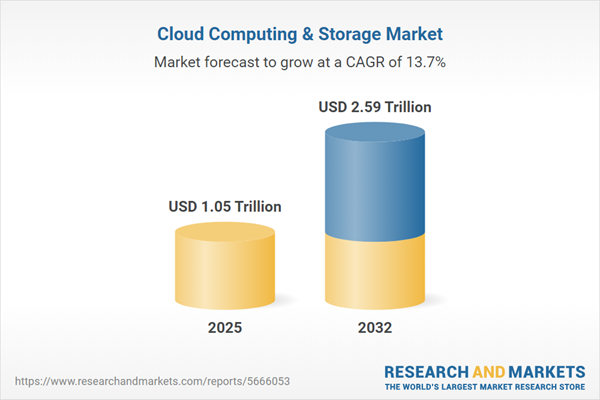Speak directly to the analyst to clarify any post sales queries you may have.
Cloud computing and storage continue to redefine enterprise IT landscape as organizations pursue digital transformation, operational agility, and scalable growth amid evolving business needs and security requirements. Strategic investments in these technologies are accelerating innovation, collaboration, and competitive positioning for enterprises globally.
Market Snapshot: Cloud Computing & Storage Market Growth
The Cloud Computing & Storage Market grew from USD 929.14 billion in 2024 to USD 1.05 trillion in 2025, and is forecasted to sustain strong expansion with a CAGR of 13.72%, reaching USD 2.59 trillion by 2032.
Scope & Segmentation
This report thoroughly analyzes the landscape, technologies, and end-user trends shaping cloud computing and storage adoption worldwide. Coverage spans critical market drivers, strategic challenges, service models, deployment approaches, and vendor ecosystems.
- Service Types: Backup As A Service, Disaster Recovery As A Service, Infrastructure As A Service, Platform As A Service, Software As A Service, Storage As A Service
- Cloud Service Components: Compute, Database (including Data Warehousing As A Service, NoSQL Database As A Service, Relational Database As A Service), Networking (Content Delivery Network, Load Balancing, Virtual Private Network), Security and Compliance (Data Encryption, Identity and Access Management, Threat and Intrusion Management), Storage
- Deployment Models: On Cloud, On Premise
- Organization Sizes: Large Enterprises, Small and Medium Enterprises
- End-User Industries: Banking Financial Services and Insurance, Education, Government and Public Sector, Healthcare and Life Sciences, IT and Telecom, Manufacturing, Media and Entertainment, Retail and E-Commerce
- Regions: Americas (United States, Canada, Mexico, Brazil, Argentina, Chile, Colombia, Peru), Europe, Middle East & Africa (United Kingdom, Germany, France, Russia, Italy, Spain, Netherlands, Sweden, Poland, Switzerland, United Arab Emirates, Saudi Arabia, Qatar, Turkey, Israel, South Africa, Nigeria, Egypt, Kenya), Asia-Pacific (China, India, Japan, Australia, South Korea, Indonesia, Thailand, Malaysia, Singapore, Taiwan)
Key Takeaways for Senior Decision-Makers
- Cloud computing and storage have become foundational to digital business models, helping organizations accelerate time to value and strengthen operational resilience.
- The adoption of hybrid and multi-cloud architectures supports complex workload management, interoperability, and regulatory compliance in increasingly distributed environments.
- Composable and serverless technologies empower companies with resource flexibility, efficient development lifecycles, and the ability to rapidly scale core processes based on demand.
- Integration of artificial intelligence and machine learning is transforming data management practices, enabling automation, predictive analysis, and advanced security features across storage infrastructures.
- Regional dynamics are influencing adoption patterns, with data sovereignty, energy efficiency, and local compliance driving different cloud strategies in major global markets.
Tariff Impact on Cloud Supply Chains
Recent United States tariffs have led to higher capital expenditure on hardware components, prompting industry players to reconsider supply chain partners and manufacturing locations. These changes have shaped investment in software-defined platforms and encouraged diversification through multi-vendor strategies to alleviate operational risks and cost pressures. Contract structures and long-term procurement agreements are evolving, aiming to buffer enterprises from future tariff implications.
Research Methodology & Data Sources
Analysis combines secondary research from industry publications, regulatory reports, and vendor documentation with direct insights gathered through primary interviews with IT leaders and structured surveys of enterprise decision-makers. Statistical modeling, trend analysis, and local expert validation ensure comprehensive coverage of cloud computing and storage trends.
Why This Report Matters
- Provides actionable insights for optimizing cloud and storage investments aligned with organizational agility and security objectives.
- Equips leaders to navigate the complexities of technology integration, compliance, and vendor partnerships in diverse regulatory environments.
- Enables benchmarking against competitors’ strategies and anticipating market shifts driven by new technologies and geopolitical factors.
Conclusion
Effective cloud computing and storage decisions are key to securing business agility and resilience. Leaders leveraging data-driven insights and adaptive strategies will position their organizations for sustained advantage in the evolving digital era.
Additional Product Information:
- Purchase of this report includes 1 year online access with quarterly updates.
- This report can be updated on request. Please contact our Customer Experience team using the Ask a Question widget on our website.
Table of Contents
3. Executive Summary
4. Market Overview
7. Cumulative Impact of Artificial Intelligence 2025
Companies Mentioned
The companies profiled in this Cloud Computing & Storage market report include:- Accenture PLC
- Adobe Inc.
- Akamai Technologies, Inc.
- Alibaba Group Holding Limited
- Amazon Web Services, Inc.
- Box, Inc.
- Capgemini Services SAS
- Cisco Systems, Inc.
- Cloud Software Group, Inc.
- Cloudera, Inc.
- Cognizant Technology Solutions Corporation
- Dell Inc.
- DigitalOcean Holdings, Inc.
- Dropbox, Inc.
- Epicor Software Corporation
- Fujitsu Limited
- Google Inc. by Alphabet Inc.
- Hewlett Packard Enterprise Development LP
- International Business Machines Corporation
- Lumen Technologies
- Microsoft Corporation
- NetApp, Inc.
- Nutanix Group
- OpenText Corporation
- Oracle Corporation
- Rackspace Technology’s
- Salesforce, Inc.
- SAP SE
- ServiceNow, Inc.
- Snowflake Inc.
- Tencent Cloud
- VMware by Broadcom Inc.
- Zoho Corporation
Table Information
| Report Attribute | Details |
|---|---|
| No. of Pages | 196 |
| Published | November 2025 |
| Forecast Period | 2025 - 2032 |
| Estimated Market Value ( USD | $ 1.05 Trillion |
| Forecasted Market Value ( USD | $ 2.59 Trillion |
| Compound Annual Growth Rate | 13.7% |
| Regions Covered | Global |
| No. of Companies Mentioned | 34 |









